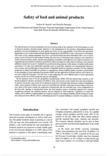Safety of feed and animal products
JIRCAS international symposium series
| ISSN | 13406108 |
|---|---|
| NII recode ID (NCID) | AA1100908X |

Full text
intlsymp-11_99-103.pdf268.72 KB
The intensification of livestock production and the increasing trade in raw materials for the feed industry, as well as livestock products, demands greater attention to risk management by all countries. International standards, guidelines and recommendations on food quality and safety are the responsibility of the Food and Agriculture Organization of the United Nations/World Health Organization (FAO/WHO) Codex Alimentarius Commission. The Codex Ad Hoc Intergovernmental Task Force on Animal Feeding has been established with a view to developing a Code of Practice on Safe Animal Feeding. The task force is examining issues relating to raw materials of animal, plant and marine origin, and discussing labeling, traceability, and inspection and control procedures. It is suggesting that feed additives should be assessed for safety and approved under stated conditions of use and that antibiotics should not be used in feedstuffs for growth-promoting purposes in the absence of public-health safety assessment. It is clear that undesirable substances such as pesticides, industrial and environmental chemicals, heavy metals, and microbiological contamination of feedstuffs should be rigorously controlled. For the industrial production of animal feedstuffs, the producer or manufacturer should establish quality assurance systems based on the principles of good manufacturing practice (GMP) and the application of hazard analysis and critical control point (HACCP) principles. The task force is also addressing the more difficult aspect of good agricultural practices (GAP) for on-farm production and use of feedstuffs.
On the particular issue of bovine spongiform encephalopathy (BSE), FAO has advised that countries at risk should implement effective surveillance for BSE in cattle, and controls on the animal feed and meat industries. At present, this means a ban on the use of animal by-products in ruminant feed, laboratory testing of slaughtered cattle, correct disposal of fallen stock, removal of specified risk materials, and improved processing of by-products. Some of the issues include the production of animal feed, the raw materials used, cross-contamination in the feed mill, labeling of manufactured feeds, the feed transport system, monitoring imported live animals, slaughtering methods, the rendering industry and the disposal of waste materials. Legislation to control the industry and its effective implementation are required, together with capacity building and the training of operatives and government officials. FAO is undertaking projects for capacity building in a number of countries at risk.
On the particular issue of bovine spongiform encephalopathy (BSE), FAO has advised that countries at risk should implement effective surveillance for BSE in cattle, and controls on the animal feed and meat industries. At present, this means a ban on the use of animal by-products in ruminant feed, laboratory testing of slaughtered cattle, correct disposal of fallen stock, removal of specified risk materials, and improved processing of by-products. Some of the issues include the production of animal feed, the raw materials used, cross-contamination in the feed mill, labeling of manufactured feeds, the feed transport system, monitoring imported live animals, slaughtering methods, the rendering industry and the disposal of waste materials. Legislation to control the industry and its effective implementation are required, together with capacity building and the training of operatives and government officials. FAO is undertaking projects for capacity building in a number of countries at risk.
| Creator | Andrew W. Speedy Daniella Battaglia |
|---|---|
| Publisher | Japan International Research Center for Agricultural Sciences |
| Available Online | |
| Issue | 11 |
| spage | 99 |
| epage | 103 |
| Language | eng |
